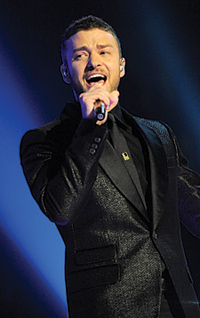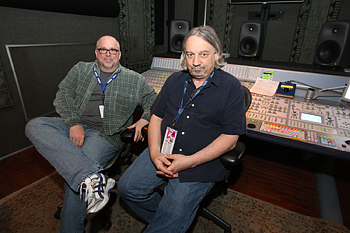Grammys Shine in 5.1

Justin Timberlake used A-T's wireless AEW-T4100 Cardioid Dynamic Microphone/Transmitter at the Grammys.LOS ANGELES
This year, the Grammy Award telecast, already the largest physical production of any annual U.S. awards show, took things up a notch with an unprecedented 25 percent increase in live music performances. With 30 songs performed on 22 different setups across four different stages, producers made a number of important changes to the broadcast audio setup at the show this year.
"Music's Biggest Night" was once again hosted by the Recording Academy at the Staples Center in downtown Los Angeles and, for the seventh year running, was broadcast in HD with 5.1 sound. Last year, as CBS put its infrastructure in place for the 2009 transition to digital, the show's host broadcaster requested only a 5.1 soundtrack, without the dedicated stereo mix for SD viewers of previous years; this year saw a continuation of that policy.
"For anyone listening in 2.0 on two speakers on their television, which at any given time is about 90 per cent of the audience, that 2.0 mix is derived from the 5.1, which happens at your set top box," said Hank Neuberger, a supervisor of the Grammy Awards broadcast audio. "So we have to transport a surround soundtrack from here to New York to the satellites to the cable headends to the home. But we have to have some confidence that the way we're monitoring the downmix here is the way it's getting to your home."
CONFIDENCE LEVELS
Onsite support from Dolby Labs assured that confidence in two key areas. With CBS carrying only a 5.1 audio stream and relying on set-top boxes and receivers to downmix to 2.0, according to Neuberger, "We really rely on Dolby and their engineers to set [the Dolby encode/decode and monitoring tools] up and match the CBS metadata parameters."
Dolby additionally provided LM100 measurement tool for each mix position so that mixers could get an accurate view of the show's dialnorm settings. That added one more level of confidence to ensure a more uniform and accurate signal, said Neuberger.
For the 51st annual Grammy Award show, XM Productions/Effanel Music's Nova music mixing remote truck was used in tandem with the company's larger L7 vehicle to allow each artist's representatives to fine-tune their pre-mixes leading up to the broadcast. In previous years, a mirror-image mixing setup was established in a temporary Gelco building next to L7, and once an artist finished their allotted one-hour production rehearsal the music mix was carried on a hard drive to the neighboring mix room for further work offline. But this year, with L7, which is outfitted with a Digidesign ICON D-Command, and Nova, which boasts a D-Control, both offering MADI connectivity, a mix was available at the secondary mix position as soon as the artist stepped off the stage. That reportedly created as much as 18 additional hours of rehearsal time for music mixers John Harris and Eric Schilling, in consultation with artists' representatives. During the telecast, Harris and Schilling typically "tag team," mixing alternate performances during the three- and-a-half-hour show. Another important change was made in the bowels of the Staples Center, where the dual-unit NEP Denali Summit remote HD truck was at the Grammy Awards for the first time. The two 53-foot expansion trailers, designed specifically for entertainment shows, were launched in September 2008 and house one of the largest Calrec Alpha with Bluefin consoles ever commissioned.
The 96-fader Alpha supports a total of 480 mono equivalent mixable channels, all with dynamics and routing, on two layers, said Summit's audio engineer, Hugh Healy, during setup. "We have 144 fiber in-puts from the stage to the truck with 48 returns, plus another 32 in each direction of line level for miscellaneous feeds," he said. Calrec has their own proprietary Hydra fiber system, which offers extremely low latency and is very high quality."
AUDIENCE MIX
Another change this year was the use of a Holophone single point source 5.1 mic to capture audience response, together with another two-dozen mics deployed around the arena.
"We're always looking for where the hotspots in the audience are in an industry event," Neuberger said. "I'm a giant fan of this device; it's perfect for us." In past years a separate engineer submixed the audience spot mics, but this year, according to Neuberger, Tom Holmes, returning as broadcast mixer for his third year, "felt he could get a faster response and bring that energy of the fans into the mix much quicker if he had those audience faders on his desk."

Music mixers John Harris (L) and Eric Schilling mixed alternate performances on the Digidesign ICON in the XM/Effanel L7 truck during the Grammy Awards telecast In all, more than 600 microphones were used for the many performer backline setups and vocals. Wireless vocal and presenter mics comprised another 46 channels, with 10 RF instruments, all overseen by RF coordinator David Bellamy of Soundtronics Wireless in Burbank, Calif. Audio-Technica, Sennheiser and Shure brands annually account for the majority of the mics used on the telecast.
Audio-Technica supplied more than 250 hard-wired mics and Artist Elite 5000 Series UHF wireless systems. High-profile A-T RF mic users included Justin Timberlake, Jay-Z, Taylor Swift, Estelle, T.I., Lil Wayne, Stevie Wonder, Boyz II Men, Al Green, and Jamie Foxx, Duke Fakir and Ne-Yo in a tribute to the Four Tops. Kenny Chesney and Thom Yorke of Radiohead each used A-T wired vocal mics.
For its part, Sennheiser fielded 120 mics for backline and production use, including more than 40 e602 and two-dozen e604 wired mics for drums and percussion, as well as eight each of the MKH 8040 and MKH 416 models. Neumann mics included TLM 103, TLM 49 and KM 184 instrument mics. Two-time Grammy-winner Adele made prominent use of a Neumann KMS 105 vocal mic, with the Jonas Brothers and Miley Cyrus making use of Sennheiser 5200 RF handhelds.
Shure accounted for a dozen RF mic channels devoted to musical performances at the show, comprising UHF-R systems with a combination of KSM9 and SM58 capsules. U2's Bono, in the show opener, wielded a UHF-R handheld transmitter with an SM58 capsule, while Sir Paul McCartney, and Robert Plant and Alison Krauss, were all on hardwired SM58s.
Get the TV Tech Newsletter
The professional video industry's #1 source for news, trends and product and tech information. Sign up below.
